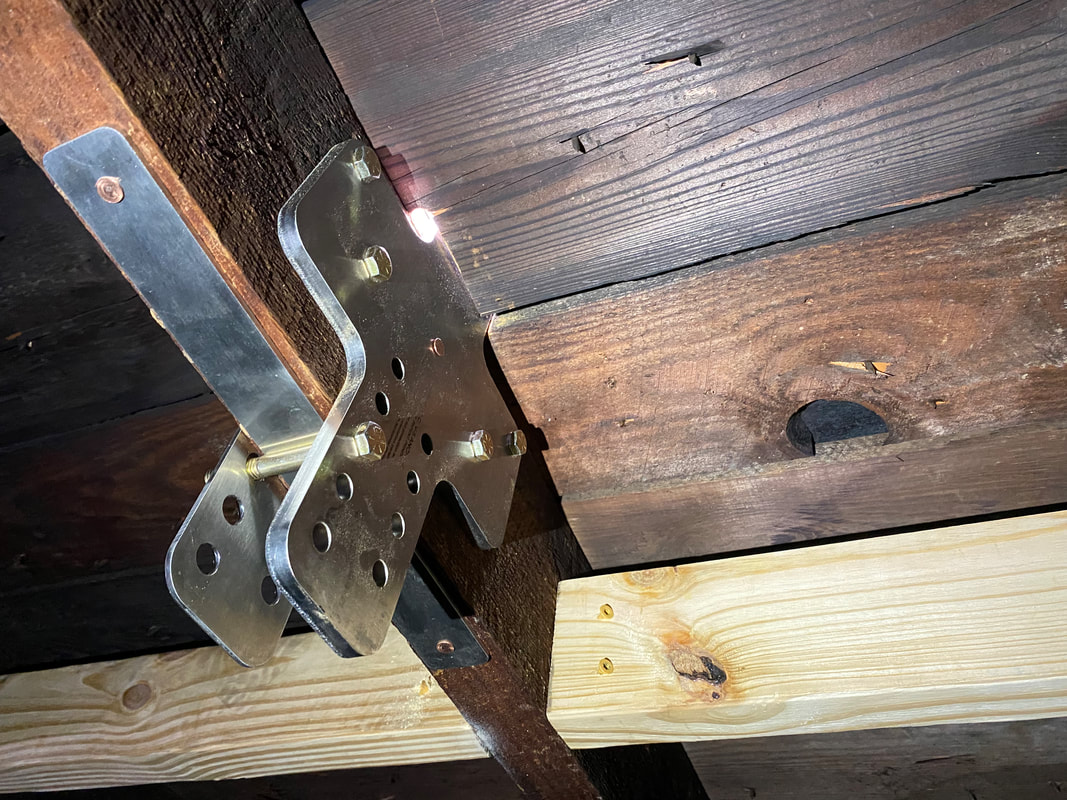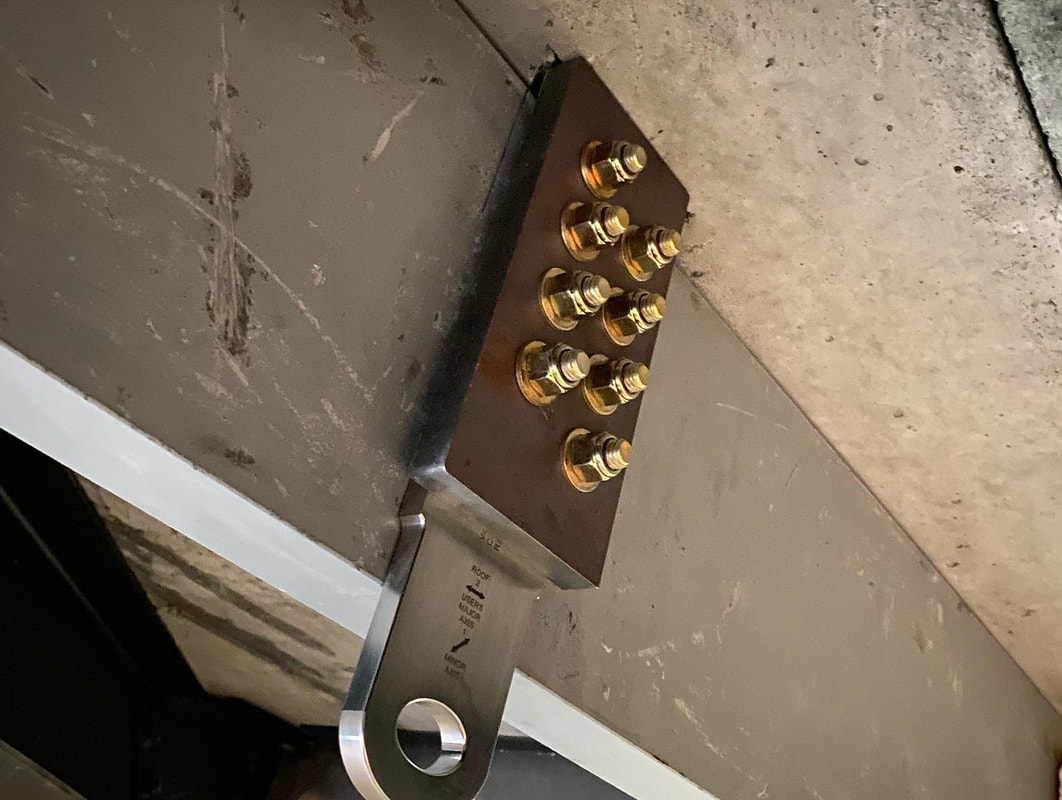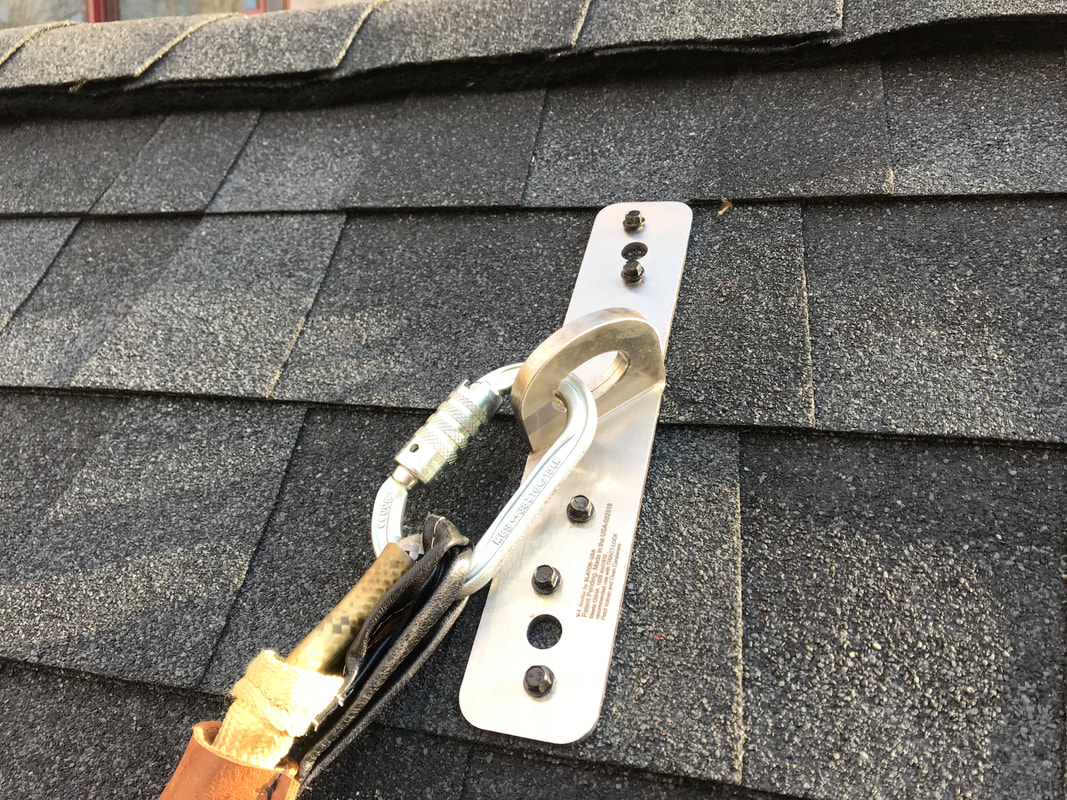 How many roof anchors do I need for fall protection? Architects, builders, roofers and homeowners regularly ask me the question, “How many anchors do I need on my roof?” Maximum = How many will it take for a worker of normal skill, with normal gear and fall protection training to safely access the part of the roof that needs attention? Keep in mind that anchor locations should be chosen so that any slip/fall should not allow the user (with a tightly kept rope) to go over the edge/eve of the roof. A swing over the edge of the roof creates an entirely different set of challenges and an urgent rescue timeline. A six-minute suspension, in the wrong type of harness, from a dorsal ring can easily and quietly kill a person (even after the rescue). For more information, perform an internet search with the key words, “suspension trauma”. Minimum = How many anchors will it take to immediately and safely perform the task of the day? These anchors may be temporarily installed onto the roof, they may be permanent anchors, and if you have a highly skilled repair team, they may consist entirely of ropes. However, besides us or some of our clients, I’ve never encountered a roofing repair crew that kept hundreds of feet of ANSI rated rope and the climbing gear readily available to meet the day’s challenge. So, what happens is that most teams simply take risks that are unnecessary. Interestingly, a German colleague told me they installed permanent anchors every 2 meters on their roofs. They also have one of the most advanced roofing apprenticeship and training programs in the world. They are dedicated to their craft, and safe working conditions ... both seem like good ideas. For a more thorough explanation about roof anchor placement, please read on and take time to understand what sets up a “series of unfortunate” events. 03/13/24 UPDATE: I've added photos of anchors from some of our various job sites to the bottom of this post. Many more photos/videos and steep roof safety tips are available on our website. Our mission is to continuously develop and share advanced techniques, systems and gear to aid steep pitch roofers in performing work safely and simply. If you visit our site www.slator-usa.com, I hope you find it helpful and if you have unanswered questions, please send us a note on our contact form and we'll do our best to assist you. Cheers! 1. Why do you think you need permanent roof anchors? The answer to this question depends completely on your point of view. This seems like a silly question, right? It should be an obvious answer. Gravity stays busy. People slip. People fall. They may become seriously injured and some die. Their families, friends, co-workers and businesses suffer severely, and for a long time. It is all easily and completely preventable with the proper anchors, gear and training. Clients want you to have safe working conditions. Workers who are not at risk of falling can concentrate better on doing their best work. It’s a win-win for everyone. As a matter of fact, I’ve never encountered a homeowner or commercial building owner who desired that I or any member of my team go without proper fall protection while we repair their roof, chimney or gutter. Probably, seventy-five percent of our homeowner or church clients have us install permanent anchors while we are repairing or replacing their roofs. However, many roofers I’ve spoken with argue that they do not want to be liable for leaving a permanent anchor on a roof. And, honestly, that’s quite understandable given the selection set of unattractive and unsafe anchors available on the market, today’s litigious society, every roof penetration is a leak opportunity, and the costs involved for anchors and training. These are valid points. Oddly, this same group usually can be seen working without any fall protection at all, or worse . . . using gear improperly for the “appearance” of fall protection (hoping to avoid a fine) just in case OSHA does a drive-by. Look for it as you drive home and truly begin noticing roofing crews. Are they wearing a harness (nowadays . . .often). Is there a rope attached (seldomly)? Is there enough slack in the rope for them to fall off the roof and hit the ground (usually)? The roofing company owners that I’ve encountered (who’ve had an employee fatality) has each spent over $100,000 simply trying to keep their business afloat prior to OSHA’s final decision (which can result in hundreds of thousands of additional costs). This does not take into account the emotional toll paid by each employee and how that affects their business as well. Residential builders often have a similar point of view. They don’t want any perceived liability and certainly don’t want the cost. They are “in business to make money” and until they can be convinced that providing permanent anchors will make them additional money (easily), or it’s the law, they will stick with their current plan. It's rare to see a deviation in a residential building contractor's thought process. Fall protection becomes the problem that each tradesperson/sub has to solve (or ignore) on their own. Commercial builders are quite different, a little more forward thinking, and often are following instructions from the architect. They follow the building plan specifications, or risk not getting paid. Every building owner that’s employed us, whether they are a University, Church, Municipality, National Park Service, or a homeowner makes decisions that bring them the most comfort solving today’s problems while keeping in mind the risks and costs coming with future maintenance. The facts always remain: Roofs and buildings require maintenance. Falls are a leading cause of injuries and death in the workplace according to OSHA. Accidents and fatalities at work are investigated and it’s the employer’s responsibility to provide a safe working environment and, document each employee’s fall protection training. Falls are fiscally, physically and emotionally expensive. And . . . they are all preventable. Today it's common for commercial clients to mandate that every roof on their campus/property must have permanent anchors installed during a building's renovations or roof replacements. Some policy changes are proactive, however sometimes they are reactive. One client had a roofer fall a handful of years ago and the worker's compensation bill exceeded $500,000 by the time we were called, and the bill will most likely continue to grow until the policy limits are reached. Now, permanent anchors are standard on all their projects. It's simply easier, safer, and less expensive to install permanent anchors and create safer working conditions when feasible. And, best of all, it may save someone's life. Permanent anchors have been specified on flat commercial roofs for years. Now they are becoming more common on steep roofs, and change usually begins with the roof consultant, architect, or an organization's director of safety. They are tasked with guiding the building owner through current and perceived future legislative and maintenance requirements effectively. Building codes evolve to help buildings last longer and become safer places to live and work. Permanent anchors will one day become a standard on most commercial and residential rooftops. Commercial window washers use “built-in” anchors regularly on tall buildings and OSHA requires fall protection for any construction work over 6 feet off the ground. It’s simply a matter of time before permanent anchors on rooftops become as natural as airbags in vehicles. 2. Who will be using the anchors and what sort of training have they had? This may sound obvious, but “You can’t use, what’s not there.” When a roof, gutter, chimney, etc … needs maintenance. Eventually, someone will have to physically be there to perform the work. Will this person have the skills and training to install a temporary anchor or set up a temporary rope system? Will they put holes in the roof to install this anchor and feel the risk of jeopardizing the roofing manufacturer's warranty? Unfortunately, even most roofers skip installing temporary anchors during repair jobs because they do not want to fix another spot on the roof. Oddly, most also believe they will never fall, although they all know someone who has fallen. It is quite similar to smokers not believing they will ever get lung cancer. It will happen to someone else, right? I’ve never seen a painter install a temporary anchor, and I’ve seen hundreds of roofer’s anchor installations over the years and (with exception to our own team) have rarely seen a roof anchor installed according to the manufacturer’s direction. It takes desire, understanding, time, skill, and the proper fasteners and tools to install a temporary roof anchor. Once a worker is on the job, usually the "get ‘r done" attitude takes over and they “get by” with whatever they’ve got, or too often, simply go without. So, here’s the point. The less supervision/skill/training/gear the potential user has, the more help they need to get the job done safely. Ideally, the anchors should be positioned in such a way, that a novice repair person can see their anchor, and choose the anchor that will help them keep the shortest possible rope tight and avoid any swing or fall that would result in them going over the edge of the roof. A good rule of thumb is that an anchor point is set above every object that requires regular maintenance, such as a chimney. An anchor point should be within reach of each regular roof access point, such as a roof hatch or obvious popular ladder access path. An anchor point should be on almost every roof surface. If not, then plans should be made so that workers can easily be on that surface utilizing a different anchor point safely. The distance between anchors is six feet less than the distance from the anchor point to the eve (edge) of the building. This allows a worker (who keeps a tight rope) to move from one anchor point to the next without ever having a risk of falling off the roof. 3. How will they get to the anchors safely? Okay. Imagine taking your spouse out to the finest restaurant on your anniversary. You order an appetizer, fresh salmon, a salad, and chardonnay. After 20 minutes of enchanting background music, hand holding and reminiscing about births and graduations over the last 30 years, your wine is delivered to . . . an empty table 20 feet away and the waiter disappears. What do you do? That’s your wine and appetizers. This is YOUR anniversary. Do you dare get up and go over to get it? Nobody’s watching. It will just take a moment. The waiter should be back shortly, but the restaurant is getting busy. Just go get it. It will only take a moment. Now, imagine the restaurant is 50 feet in the air on a 8/12 pitch. Susan wants to go over to retrieve the wine? Do you want her to go? No! Of course not. You will do it instead because it may be a little slippery and YOU won’t fall. You’ve done it many times before, at work. Often, this is how the fall happens. "It won't take a moment." "I'll do it just this once." "I'll be safe." "People do this all the time." "OSHA doesn't require fall protection for inspections." Gravity doesn't care and is waiting patiently. Plan your work, then work your plan. Share your plan with those that do the work and make sure they have the gear and training to be successful. Access to the fall protection anchors is no different. Anchors, out of reach without a shared safe access plan, are not helpful. If you don't know how to get there safely, ask for training. Someone knows how to do it, and is willing to help. An architect on a recent project did a fantastic job of planning access. He specified a roof hatch with an anchor point within easy reach and then allowed us to design a "walkable" ridge with periodic anchors within reach. This provides a level walking surface for repairmen as well as helping them stay off the slate roof (which can cause breaks). He also chose an anchor system (our V-5/V-8) that has no welds, cables, clamps, or moving parts. There is no need for the "required" periodic inspections of the roof anchor. All inspections can be done from the safety of the attic, greatly reducing risk and foot traffic on the roof. Author’s note: Thank you for caring about the safety of yourself, your team, and the health of future tradespeople. We are each granted a very brief time before moving on, there’s no need to rush it along by being careless fixing a roof. I’ve never seen a statue or memorial for a roofer. We are not heroes, just nice folks trying to keep families dry. May you have safe and enjoyable roofing ... forevermore. Ronny Roseveare To summarize: There is no set number of permanent anchors a roof should have. A roof should have as many anchors as necessary for an averagely skilled and trained roofer (who uses normal, readily available fall protection gear) to reach any part of the roof with a rope angled in such a way, that any potential fall will not allow them to swing over the edge of the roof. Our team is fairly skilled and is familiar with setting up rope anchor systems. Still, most residences we service require 2 – 4 anchor points for us to reach all locations safely. Five are being installed prior to replacing the asphalt shingle roof in the photo below. They will remain in place for safely servicing this building as long as the building stands. Notice that the bolts are completely inspectable and easily replaceable from the attic. This is very helpful for trusting your anchor point. If the fasteners are not inspectable, how will the user know the anchor was installed correctly? The fasteners and anchor (of the V-5 anchor shown above) are completely inspectable from the safety of the attic. Rule of thumb for anchor inspections: If you cannot inspect it (especially the fasteners), how can you trust it? The adjustment holes in the bottom of the V-5 anchor allow for varying thicknesses of rafter and roof types. Here, you see two V-5 anchors in use on this farmhouse with beautiful 80 year old Buckingham slate in Virginia. I put our cast bronze cap on the anchors when the job was completed so they would blend in nicely with the roof. V-18 Ridge Anchor for: Asphalt shingle, Metal, Slate, Tile, Cedar.
Meets a 5,000 pound load requirement in any direction. Suitable for use with a horizontal lifeline. |
Details
AuthorRonny Roseveare advises building owners and architects about steep pitch safe access, roof maintenance, and permanent anchors. He installs permanent roof anchors, repairs roofs and trains roofing colleagues across the USA. |









